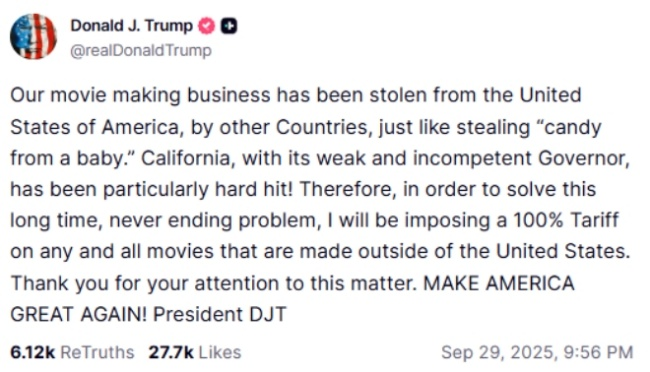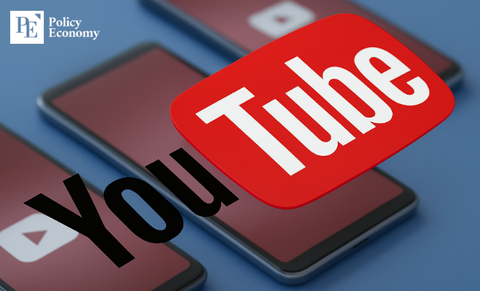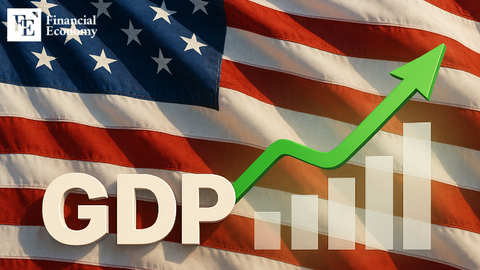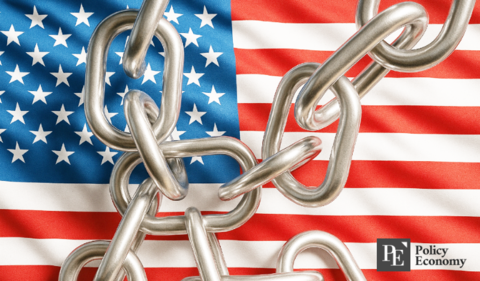Trump Threatens 100% Tariffs on Foreign Films, Adding to Hollywood’s Woes
Input
Modified
Measure for Industry Revival? Skepticism Prevails
Streaming Boom Saps Theater Vitality
Eroding Dominance of U.S.-Centered Film Ecosystem

President Donald Trump’s declaration that he will impose a 100% tariff on all films produced outside the United States has rattled the global movie industry. Hollywood, already struggling with declining audiences and the relentless rise of streaming platforms, now faces an additional source of uncertainty, while foreign cinema chains that once challenged the U.S. market are retreating altogether. Industry observers say the tariff threat is largely symbolic, while the deeper crisis stems from the rapid ascent of streaming and the increasingly multipolar global market.
Global Collaboration the Norm, Policy Feasibility in Doubt
On the 29th, Trump announced on Truth Social that “all movies made outside the United States will be subject to a 100% tariff.” He offered no details on the timing or mechanism of such a measure. The statement marks the first attempt to apply tariffs to services rather than goods, and regardless of its enforceability, it injects new uncertainty into the American film industry.
Trump voiced a similar stance in May, arguing that tax incentives were driving U.S. productions overseas and vowing to slap a 100% tariff on foreign films. At the time, he claimed “California is being hit hard,” a remark widely interpreted as an effort to rally political support by invoking Hollywood’s symbolic weight. Yet many point out that states and cities across the U.S. actively compete with one another by offering their own tax breaks, making it simplistic to blame foreign governments for Hollywood’s decline.
Within the U.S. film community, skepticism over the plan’s feasibility dominates. Most Hollywood productions are shot across borders, with visual effects and postproduction outsourced to hubs in Canada, the U.K., or Australia. In such a system, it remains unclear whether a film would be deemed “foreign” if even 1% of its budget is spent abroad, or if tariffs would be imposed proportionally.
Complicating matters further are the financing and distribution structures. Content today is often co-financed and co-produced by multinational partnerships, blurring the line between domestic and foreign. Films are also not traded across borders like physical goods; they are distributed digitally and consumed globally via streaming platforms. Against this backdrop, most of Hollywood views Trump’s proposal as incapable of reviving the industry in any substantive way.

Hollywood Already on Shaky Ground
For much of the 20th century, Hollywood reigned as the global capital of cinema. That dominance has been eroding. According to box office tracker The Numbers, U.S. films accounted for 69.5% of global theatrical revenue last year, down more than 20 percentage points from levels above 90% in 2009–2010, and well below the 85.6% recorded in 2014. Over the same period, China’s share rose from 5.5% to 16.5%, while Japan expanded from 0.6% to 4.9%, buoyed by the strength of its animation sector.
The pandemic served as the tipping point. With audiences slow to return to theaters after COVID-19, platforms like Netflix became ingrained in daily life. Research firm Gower Street Analytics estimated last year’s North American box office revenue at $8.8 billion, more than 20% below the 2017–2019 average of $11.5 billion. As audience bases shrank, studios grew more risk-averse, concentrating on franchises and family-friendly films. This, in turn, stifled creativity and diversity, feeding into a cycle of decline.
Hollywood’s financing environment has also deteriorated. The once-dependable flow of Chinese investment has dwindled, leaving studios with tighter budgets and little room for experimentation. A massive writers’ and actors’ strike in 2023 delayed production for months, while the war in Ukraine effectively cut off the Russian market. This year, California wildfires damaged filming locations, adding to the string of setbacks.
Even star power has waned. Once outspoken on global issues, many Hollywood actors have grown cautious, wary of political polarization and fan backlash. While some endorsed candidates in last year’s election, their influence on the outcome was negligible. Most remained silent on international crises like the conflict in Gaza. The rare exception was Zoe Saldaña, who addressed her experience as an immigrant actress at the Academy Awards. Critics argue that if Hollywood continues to lose both its star aura and its spirit of diversity and daring, it will never regain its former shine.
Lessons from CGV’s U.S. Exit
The recent withdrawal of CJ CGV, South Korea’s largest multiplex chain, underscores the structural crisis gripping the theater business. On the 21st, CGV shuttered its Los Angeles location, pulling out of North America entirely. The move came just five months after transferring operations of its Buena Park site to Regency Theatres, ending a 15-year expansion effort in the U.S. The episode laid bare that theaters are no longer central to content consumption.
Streaming proved to be CGV’s greatest obstacle. Since the pandemic, global platforms like Netflix, Disney+, and HBO Max have surged, and audiences have grown accustomed to on-demand content at home. Moviegoing worldwide has plummeted, and theaters have slipped from “essential” to “optional.” With streaming’s convenience and diversity winning over consumers, traditional cinemas have steadily lost ground.
Experts argue that reviving the U.S. theater industry requires innovation, not tariffs. As streaming transcends borders and chips away at theatrical attendance, simply adding more screens is seen as outdated. Instead, analysts suggest redefining the theater experience through premium auditoriums, exclusive content, advanced technologies, and community-driven events. For many in the industry, the real threat lies not in tariffs but in the rise of streaming and the global fragmentation of the market. Without bold adaptation, they warn, the decline of American cinema will only accelerate.






















Comment